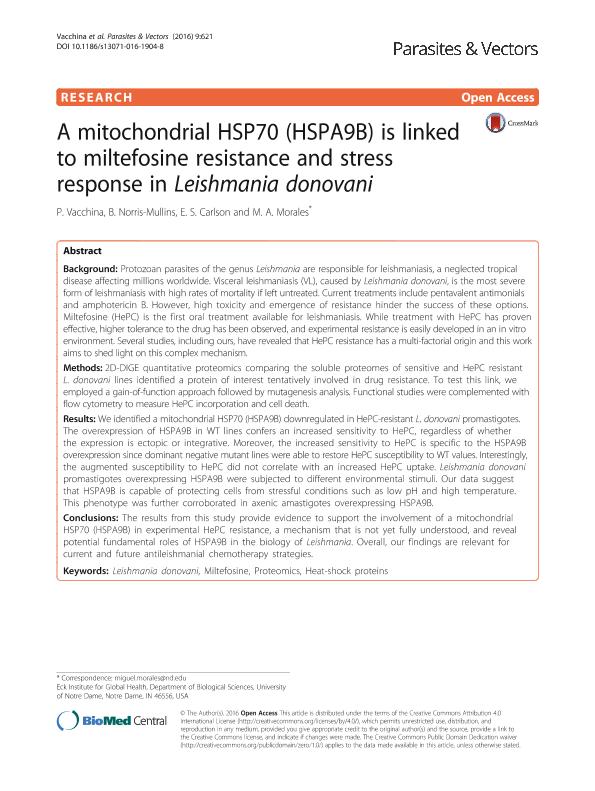Artículo
A mitochondrial HSP70 (HSPA9B) is linked to miltefosine resistance and stress response in Leishmania donovani
Fecha de publicación:
12/2016
Editorial:
BioMed Central
Revista:
Parasites and Vectors
ISSN:
1756-3305
Idioma:
Inglés
Tipo de recurso:
Artículo publicado
Clasificación temática:
Resumen
Background: Protozoan parasites of the genus Leishmania are responsible for leishmaniasis, a neglected tropical disease affecting millions worldwide. Visceral leishmaniasis (VL), caused by Leishmania donovani, is the most severe form of leishmaniasis with high rates of mortality if left untreated. Current treatments include pentavalent antimonials and amphotericin B. However, high toxicity and emergence of resistance hinder the success of these options. Miltefosine (HePC) is the first oral treatment available for leishmaniasis. While treatment with HePC has proven effective, higher tolerance to the drug has been observed, and experimental resistance is easily developed in an in vitro environment. Several studies, including ours, have revealed that HePC resistance has a multi-factorial origin and this work aims to shed light on this complex mechanism. Methods: 2D-DIGE quantitative proteomics comparing the soluble proteomes of sensitive and HePC resistant L. donovani lines identified a protein of interest tentatively involved in drug resistance. To test this link, we employed a gain-of-function approach followed by mutagenesis analysis. Functional studies were complemented with flow cytometry to measure HePC incorporation and cell death. Results: We identified a mitochondrial HSP70 (HSPA9B) downregulated in HePC-resistant L. donovani promastigotes. The overexpression of HSPA9B in WT lines confers an increased sensitivity to HePC, regardless of whether the expression is ectopic or integrative. Moreover, the increased sensitivity to HePC is specific to the HSPA9B overexpression since dominant negative mutant lines were able to restore HePC susceptibility to WT values. Interestingly, the augmented susceptibility to HePC did not correlate with an increased HePC uptake. Leishmania donovani promastigotes overexpressing HSPA9B were subjected to different environmental stimuli. Our data suggest that HSPA9B is capable of protecting cells from stressful conditions such as low pH and high temperature. This phenotype was further corroborated in axenic amastigotes overexpressing HSPA9B. Conclusions: The results from this study provide evidence to support the involvement of a mitochondrial HSP70 (HSPA9B) in experimental HePC resistance, a mechanism that is not yet fully understood, and reveal potential fundamental roles of HSPA9B in the biology of Leishmania. Overall, our findings are relevant for current and future antileishmanial chemotherapy strategies.
Palabras clave:
Heat-Shock Proteins
,
Leishmania Donovani
,
Miltefosine
,
Proteomics
Archivos asociados
Licencia
Identificadores
Colecciones
Articulos(IBR)
Articulos de INST.DE BIOLOGIA MOLECULAR Y CELULAR DE ROSARIO
Articulos de INST.DE BIOLOGIA MOLECULAR Y CELULAR DE ROSARIO
Citación
Vacchina, Paola; Norris Mullins B.; Carlson, E. S.; Morales, M. A.; A mitochondrial HSP70 (HSPA9B) is linked to miltefosine resistance and stress response in Leishmania donovani; BioMed Central; Parasites and Vectors; 9; 1; 12-2016; 1-15
Compartir
Altmétricas




